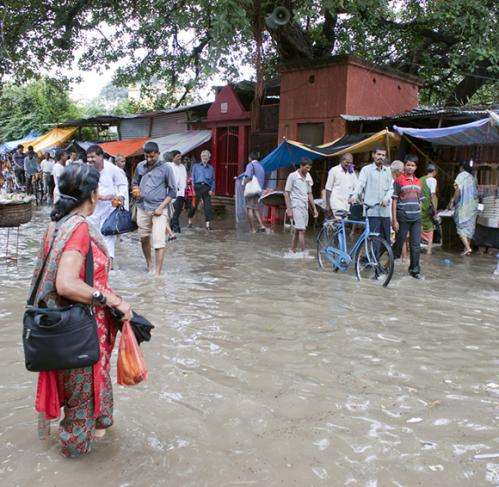Slow trumps fast in changing the summer monsoon

(Phys.org)—Researchers at Pacific Northwest National Laboratory traced the different ways pollution particles change summer monsoon rainfall in South Asia. They found that pollution's effect through "slow" processes, affecting the region over weeks to months, has a more extensive impact on the monsoon than the "fast" processes occurring in a matter of days. Monsoons are an important climatic feature of our planet, and understanding the factors that influence monsoon behavior is a fundamental challenge for climate science. Their work was published in the Geophysical Research Letters.
"Our results show that the slower impact of aerosols-cooling down sea surface temperatures-is more profound than their faster direct impacts through atmospheric heating, changes in clouds, and cooling land surface when it comes to shaping the behavior of the monsoon system," said Dr. Dilip Ganguly, atmospheric scientist at PNNL and lead author of the study. "But both slow and fast effects are important."
Monsoons affect about half the population of the Earth. Summer monsoons deliver about three quarters of the annual rainfall to South Asia, influencing the fresh water supply, agriculture, and energy production. Small changes in monsoons can have a large impact on local living conditions, affecting crop yields, prolonging droughts, or fostering floods. Monsoons also affect the global circulation, producing world-wide impacts. That's why it's important to understand factors that may change monsoons, including emissions of pollution particles (a.k.a. aerosols). In this study, PNNL researchers delved into the different ways that pollution particles influence the South Asian summer monsoon rainfall.
PNNL researchers used the Community Earth System Model (CESM) to study the effect of human-caused pollution particles on the South Asian summer monsoon. The CESM is a three-dimensional global climate model that predicts changes in features of the atmosphere, ocean, land and ice from different climate forcing agents like greenhouse gases and pollution.
The researchers explored the climate response to aerosol particle emissions by varying the emissions between pre-industrial and present-day values and monitoring the model response to those changes.
While both fast and slow climate responses to pollution particles are important, they found the slow and fast changes influence precipitation patterns differently over South Asia.
"The processes changing sea surface temperatures influence the whole of South Asia, while the aerosol processes that affect land and atmosphere temperatures have a somewhat weaker impact and shift the precipitation to the west a bit," said Ganguly.
Aerosols emissions from Asia have been increasing rapidly with the enormous regional changes in society and industry. Emissions are likely to change again from the many new technological advances and increasing local concerns about emissions' impact on health and ecosystems. Researchers are interested in comparing and assessing the impacts of emissions from Asia with those from other parts of the planet.
More information: Ganguly D, PJ Rasch, H Wang, and J-H Yoon. "Fast and Slow Responses of the South Asian Monsoon System to Anthropogenic Aerosols." Geophysical Research Letters 39, L18804. DOI:10.1029/2012GL053043
Journal information: Geophysical Research Letters
Provided by Pacific Northwest National Laboratory


















